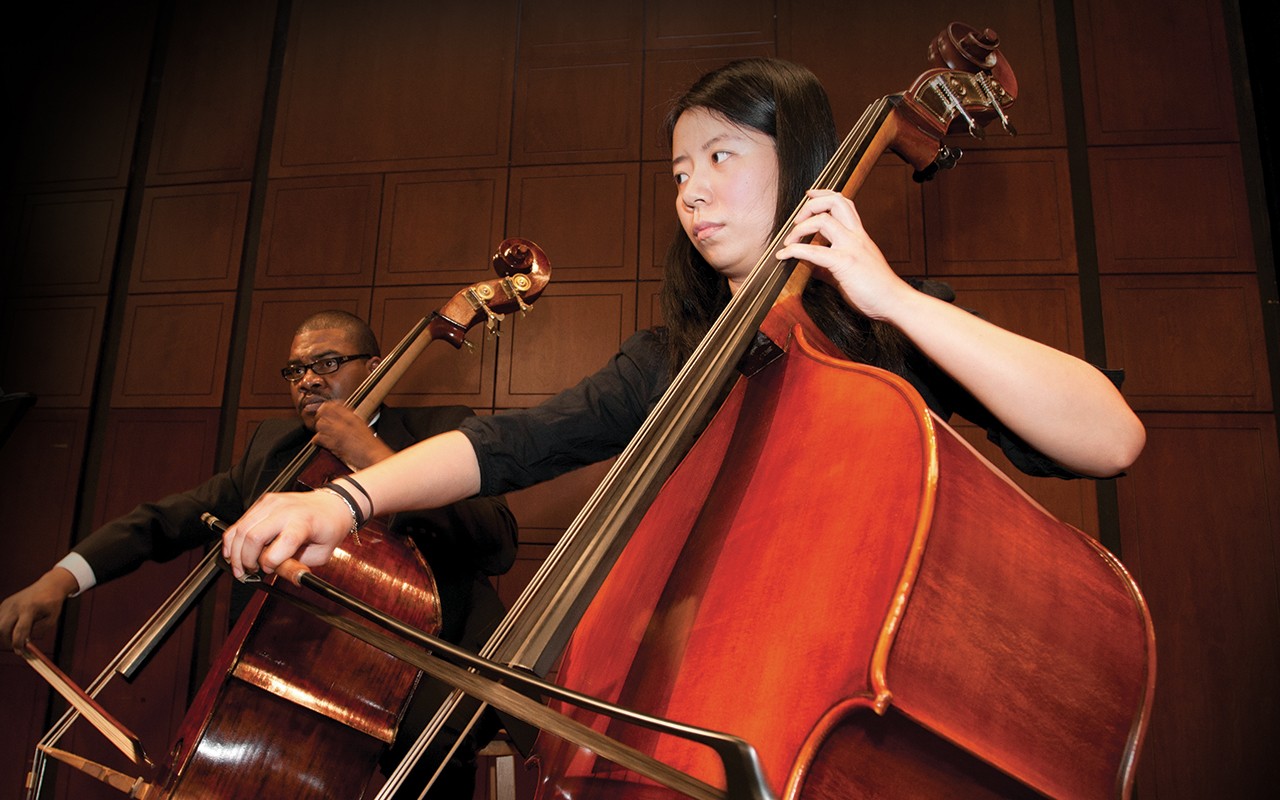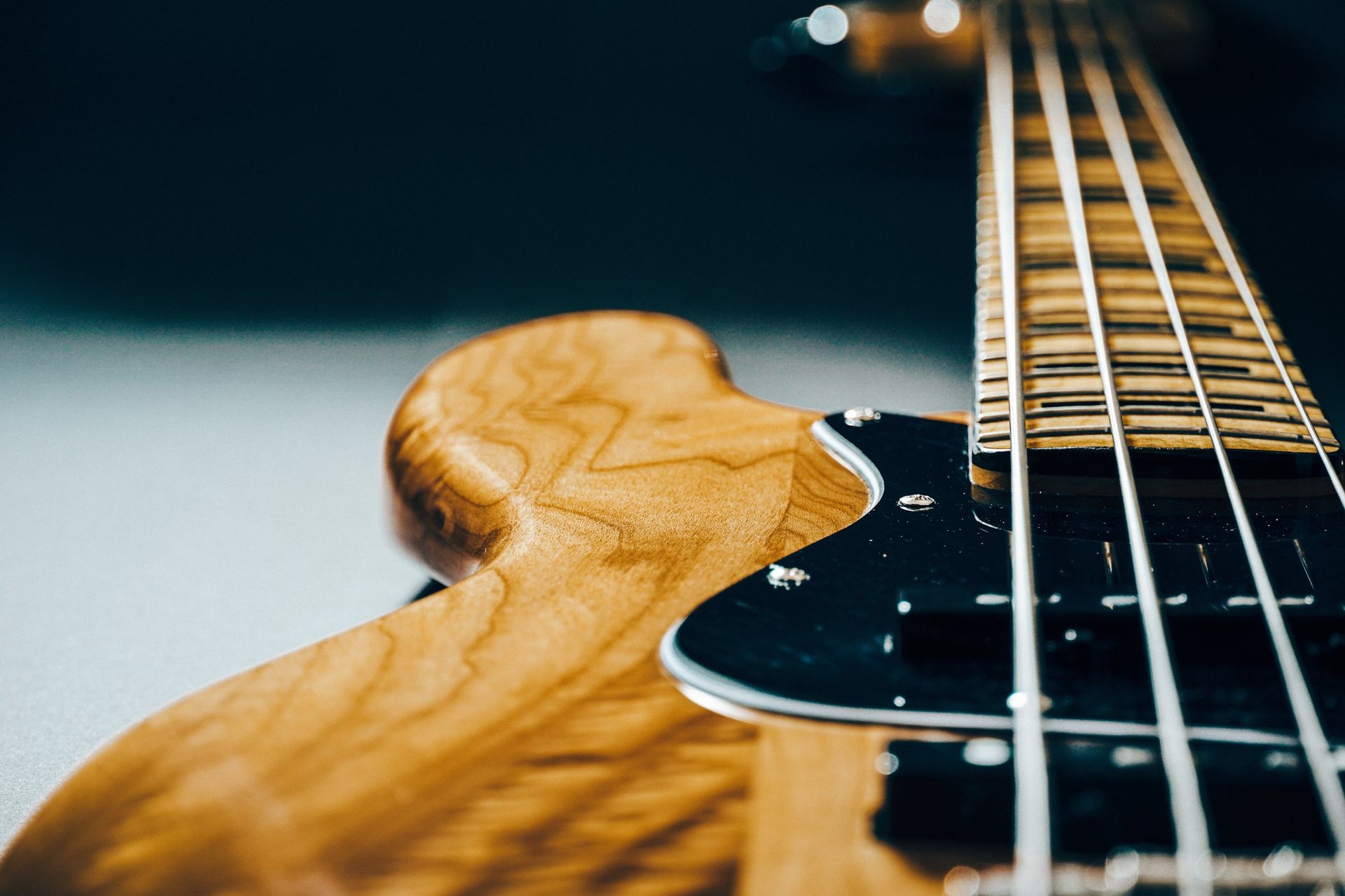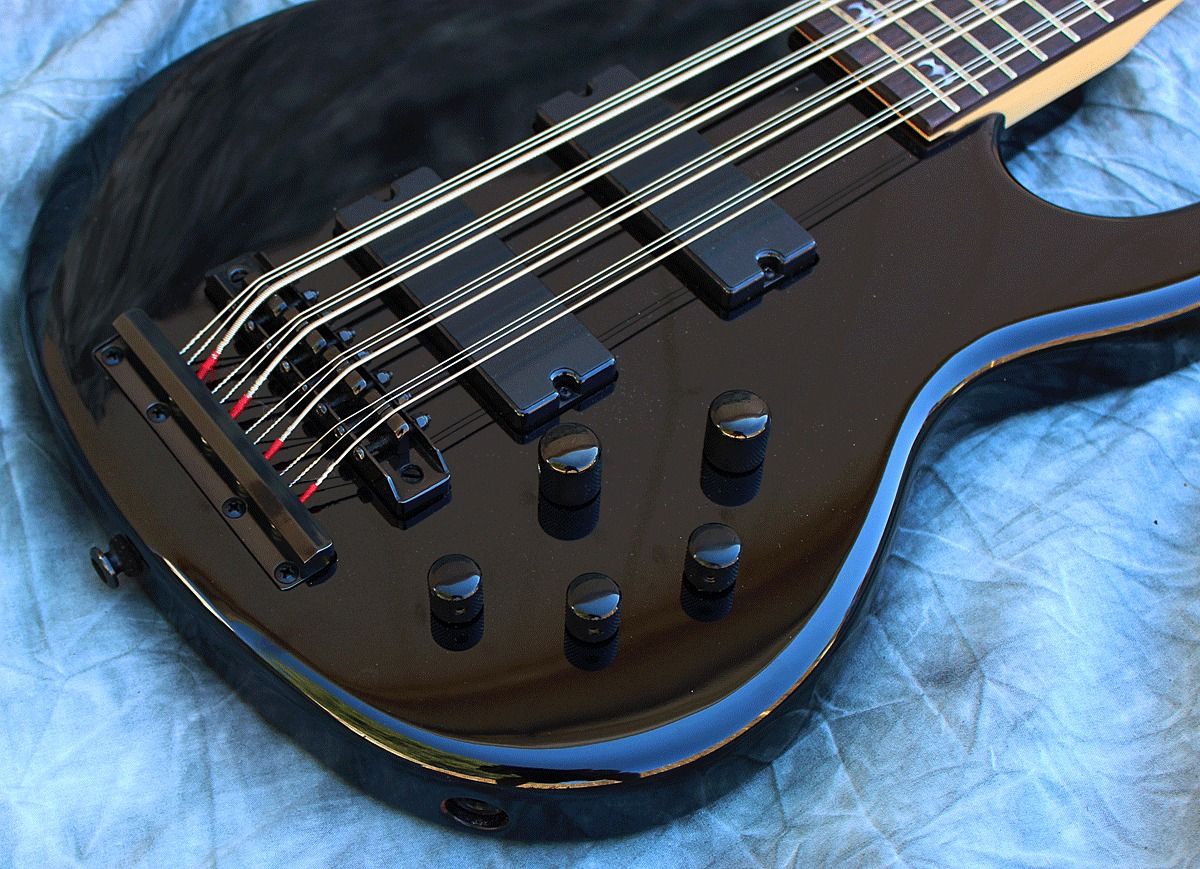Home>Instruments>Bass>What Is Double Bass


Bass
What Is Double Bass
Modified: January 22, 2024
Discover everything you need to know about the double bass, from its history and construction to how it's played. Explore this versatile instrument commonly known as the bass.
(Many of the links in this article redirect to a specific reviewed product. Your purchase of these products through affiliate links helps to generate commission for AudioLover.com, at no extra cost. Learn more)
Table of Contents
- Introduction
- Definition of Double Bass
- History and Evolution of Double Bass
- Anatomy and Components of Double Bass
- Playing Techniques and Styles with Double Bass
- Notable Double Bass Players
- Famous Double Bass Compositions
- Importance and Role of Double Bass in Music
- Modern Applications and Innovations with Double Bass
- Conclusion
Introduction
The double bass, often referred to as the contrabass or upright bass, is a large, deep-toned string instrument that serves as the foundation of the bass line in many musical genres. Its grand presence and rich timbre make it an essential component in orchestras, jazz ensembles, and various other musical settings.
With origins dating back centuries, the double bass has a fascinating history and has seen countless variations and improvements over time. It boasts a unique role in providing the rhythmic and harmonic structure of a piece, acting as a bridge between the lower and higher registers of a musical composition.
Playing the double bass requires skill, strength, and precision. The instrument is played vertically, with the player standing or seated on a stool, while manipulating the strings with a bow or plucking them with their fingers. Its deep resonance adds depth and richness to music, creating a solid foundation upon which the rest of the ensemble can build.
Throughout this article, we will delve into the definition, history, anatomy, playing techniques, notable players, famous compositions, and modern applications of the double bass. By the end, you will have a comprehensive understanding of this majestic instrument and its profound impact on the world of music.
Definition of Double Bass
The double bass, also known as the contrabass or upright bass, is the largest and lowest-pitched member of the string instrument family. It is often considered the backbone of the rhythm section in various musical genres, providing a deep and resonant bass line that complements other instruments and holds the harmonic foundation of a piece.
With its imposing size and acoustic capabilities, the double bass produces a rich, full-bodied sound that can be felt as much as it is heard. Its deep, rumbling tones provide a sense of power and depth to the music, adding a distinct layer of texture and gravity.
The instrument is typically made up of several components. The body of the double bass is large and hollow, resembling a rounded wooden chamber. It is usually made from spruce or maple, known for their resonance and durability. The top of the body, known as the soundboard, is responsible for projecting the sound and vibrating in response to the strings.
The neck of the double bass extends upwards from the body and holds the fingerboard, where the player presses down on the strings to produce different pitches. The strings on a double bass are traditionally made of gut but can also be made from steel or synthetic materials depending on the player’s preference and the musical style.
To produce sound, players can use either a bow, known as arco, or their fingers, known as pizzicato. When using a bow, the player draws it across the strings, creating a sustained and smooth sound. Pizzicato involves plucking or snapping the strings with the fingers, producing a more percussive and articulated tone.
The double bass is an integral part of orchestral compositions, jazz ensembles, folk music, and various other musical genres. Its deep, resonant sound adds depth and richness to the overall sound, providing a solid foundation for the rest of the ensemble to build upon.
Throughout history, the double bass has undergone numerous transformations, from its early predecessors in Medieval and Renaissance times to the modern instrument we recognize today. It has evolved in terms of design, construction, and playing techniques, adapting to the needs of different musical styles and performers.
In the following sections, we will delve deeper into the historical evolution of the double bass and explore its anatomy, playing techniques, notable players, famous compositions, and modern applications. By the end, you will have a comprehensive understanding of this extraordinary instrument and its contribution to the world of music.
History and Evolution of Double Bass
The origins of the double bass can be traced back to the 15th century, with its earliest known predecessors being the viols and violones, which were played primarily in Medieval and Renaissance ensembles. These early instruments had similarities in shape and construction to the modern double bass but had fewer strings and a lighter build.
As music evolved, composers began to write more complex and demanding pieces, requiring a deeper and more resonant bass sound. In response to this demand, the double bass as we know it today started to emerge in the late 17th century. It featured a larger body and a longer scale length, allowing for greater volume and richness of tone.
Throughout the 18th and 19th centuries, the double bass underwent further refinements. Players and luthiers experimented with different materials, such as spruce and maple, to optimize the instrument’s acoustic properties. The addition of a fourth string, tuned to low E, became standard practice, giving the bass a wider range and greater versatility.
The 19th century brought significant changes to the playing technique of the double bass. With the rise of virtuoso players, new techniques such as the use of harmonics, double stops, and extended techniques like slapping and thumbing became more prevalent. These advancements pushed the boundaries of what was possible on the instrument and expanded its expressive capabilities.
At the beginning of the 20th century, jazz emerged as a popular genre, and the double bass found a new home in the rhythm sections of jazz bands. Jazz bassists brought their unique style and approach to playing, incorporating walking bass lines, syncopated rhythms, and improvisation. This marked a significant shift in the role and prominence of the double bass in popular music.
In the modern era, the double bass continues to evolve and adapt to new musical styles and contexts. Electric upright basses have been developed, offering a more portable and amplified alternative to the traditional acoustic double bass. This innovation has allowed bassists to explore new sound possibilities and experiment with different genres beyond the traditional classical and jazz settings.
Overall, the history and evolution of the double bass showcase its enduring significance in the world of music. It has proven to be a versatile instrument, capable of providing a solid foundation in orchestras, jazz ensembles, and popular music genres. The ongoing advancements in construction, playing techniques, and technology ensure that the double bass will remain an essential component of the musical landscape for years to come.
Anatomy and Components of Double Bass
The double bass consists of several distinct components that work together to create its unique sound and functionality. Understanding the anatomy of the instrument is essential for players and enthusiasts alike.
The body of the double bass is the largest and most visually striking part. It is typically made from high-quality tonewoods such as spruce or maple, known for their resonance and strength. The body is hollowed out, creating a resonating chamber that amplifies the vibrations produced by the strings.
At the top of the body is the soundboard, also known as the top plate. It is usually made of spruce and is responsible for transmitting the vibrations from the strings to the surrounding air, resulting in sound projection. The soundboard is carefully carved and shaped to optimize acoustic properties and enhance the instrument’s tonal qualities.
Beneath the soundboard lies the bass bar, a wooden brace that runs along the length of the instrument’s top plate. The bass bar adds structural support and helps distribute vibrations evenly, contributing to the overall sound production and resonance.
The neck of the double bass extends upwards from the body and carries the fingerboard. It is traditionally crafted from maple, providing strength and stability. The fingerboard is usually made of ebony or other dense woods and is where the player presses down on the strings to change pitches. Frets are not used on the double bass; instead, the player relies on their ear and technique to accurately produce the desired notes.
Connecting the body and the neck is the scroll, a decorative element that adds aesthetic appeal to the instrument. The scroll is intricately carved and often features intricate patterns or designs, showcasing the craftsmanship of the luthier.
The strings are a crucial component of the double bass. Traditionally, they were made of gut, offering a warm and nuanced tone. However, modern bassists often prefer steel or synthetic core strings for their durability and stability. The double bass typically has four strings, tuned to E1, A1, D, and G, with the lowest string (E1) producing the deepest pitch.
To support the instrument and provide a comfortable playing position, the double bass is equipped with an endpin. This extendable rod is positioned at the bottom of the instrument and can be adjusted to accommodate the height and preferences of the player. By resting the endpin on the floor or a support system, the bassist can maintain stability while playing.
Other components of the double bass include the tailpiece, which holds the strings and allows for their attachment and adjustment, and the tuning pegs, used to tune the strings to the desired pitch.
Understanding the various components of the double bass allows players to develop a deeper connection with the instrument and appreciate its intricate construction. Each element plays a crucial role in producing the instrument’s distinctive sound, making the double bass a truly remarkable instrument within the world of music.
Playing Techniques and Styles with Double Bass
The double bass is a versatile instrument that offers a wide range of playing techniques and is featured in various musical styles. Understanding these techniques and styles is essential for any aspiring double bass player or music enthusiast.
One of the primary techniques used on the double bass is arco, which involves playing the strings with a bow. This technique allows for sustained notes, smooth transitions, and a wide dynamic range. The arco technique is commonly used in classical music, providing a warm and expressive sound that blends seamlessly with orchestral sections.
Alternatively, the double bass can be played using pizzicato, where the player plucks the strings with their fingers. This technique creates a more percussive and articulate sound, ideal for genres such as jazz, bluegrass, and folk music. Pizzicato allows for intricate rhythmic patterns and provides a distinct and rhythmic bass line.
The double bass is known for its prominent role in jazz music. Jazz bassists utilize walking bass lines, where they play a steady rhythm and a sequence of notes that outline the chords being played. This technique adds a sense of swing and groove to the music, providing a solid foundation for improvisation and ensemble interaction.
In addition to classical and jazz, the double bass is also featured in other styles such as rock, pop, and world music. In these genres, the bass often takes on a more supportive role, providing a rhythmic and harmonic foundation for the other instruments and vocals.
Extended techniques are another aspect of double bass playing. These include techniques such as harmonics, where the player lightly touches the string nodes to produce harmonically rich and ethereal sounds. Slapping and thumbing techniques add percussive elements to the bass line, enhancing the rhythm and groove of the music.
Styles of music that prominently feature the double bass include symphony orchestras, where it forms the backbone of the bass section. In chamber ensembles, the double bass provides a rich and resonant bass line to complement the other string instruments. It is also a key component in big band jazz, providing a solid foundation for the ensemble and driving the rhythm of the music.
Furthermore, the double bass shines in solo performances, allowing for melodic passages and virtuosic displays. Solo bass repertoire includes compositions specifically written for the instrument, showcasing its expressive capabilities and unique tone.
Whether bowing or plucking, playing in classical or jazz settings, the double bass offers a wide array of techniques and styles to explore. Its versatility and deep sound make it an indispensable instrument in various musical genres, providing a solid foundation and adding depth and richness to any ensemble or composition.
Notable Double Bass Players
Throughout history, numerous virtuoso double bass players have made significant contributions to the world of music. Their skill, innovation, and artistry have elevated the instrument and inspired generations of bassists. Here are a few notable double bass players:
- Giovanni Bottesini: Known as the “Paganini of the double bass,” Bottesini was a 19th-century Italian composer and virtuoso. He revolutionized double bass technique and composition, expanding the instrument’s capabilities and pushing the boundaries of what was thought possible.
- Gary Karr: Karr is a prominent American double bassist known for his virtuosic playing and dedication to promoting the double bass as a solo instrument. His interpretations of classical pieces and collaborations with renowned composers have made a lasting impact on the instrument’s repertoire.
- Edgar Meyer: Meyer is a versatile American double bassist and composer, known for his contributions to a wide range of musical genres, including classical, bluegrass, and jazz. His technical mastery and innovative approach have earned him recognition as one of the most influential bassists of his generation.
- Charles Mingus: Mingus, a renowned jazz bassist and composer, is celebrated for his unique improvisational style and innovative approach to composition. His contributions to the development of jazz bass playing and his ability to create intricate and melodic bass lines continue to inspire bassists around the world.
- Renaud García-Fons: García-Fons is a French double bassist known for his fusion of various musical styles, including jazz, flamenco, and world music. His technical prowess and innovative use of extended techniques have allowed him to push the boundaries of the instrument and redefine its role in contemporary music.
These are just a few of the many notable double bass players who have left an indelible mark on the instrument and its repertoire. Each of them has contributed to the development of the double bass as a solo and ensemble instrument, showcasing its capabilities and expanding its possibilities.
It is through the ingenuity and artistry of these remarkable musicians that the double bass continues to thrive and evolve, captivating audiences with its deep, resonant sound and expressive capabilities.
Famous Double Bass Compositions
The double bass has inspired composers throughout history to create exquisite compositions that showcase its unique tonal qualities and expressive capabilities. From solo works to orchestral masterpieces, here are some famous compositions that prominently feature the double bass:
- Sergei Koussevitzky – Double Bass Concerto: Written by Russian composer and bassist Sergei Koussevitzky, this concerto is considered one of the most important works in the double bass repertoire. It showcases the instrument’s virtuosity, melodic and technical capabilities, and offers a rich and demanding solo part.
- Giovanni Bottesini – Gran Duo Concertante: Bottesini’s Gran Duo Concertante for two double basses and orchestra is a showpiece that displays the agility and versatility of the instrument. It features intricate dialogues and harmonies between two basses, highlighting the instrument’s lyrical qualities and expressive range.
- Johann Sebastian Bach – Suite No. 2 in B minor for Solo Cello: While originally composed for solo cello, Bach’s Suite No. 2 is frequently performed and adapted for solo double bass. The suite consists of several movements, each showcasing different technical and musical aspects of the instrument, including melodic lines, rhythmic dances, and intricate polyphony.
- Franz Schubert – “Trout Quintet”: Schubert’s famous “Trout Quintet” is a chamber music composition that includes a prominent double bass part. The double bass provides a strong and steady foundation amidst the interplay of the piano, violin, viola, and cello, creating a balanced and harmonious ensemble.
- Edgar Meyer – Concerto for Double Bass and Orchestra: Composed by modern virtuoso Edgar Meyer, his Concerto for Double Bass and Orchestra is a showcase of the instrument’s versatility and dynamic range. This contemporary work blends classical and bluegrass elements, highlighting the double bass’s ability to transcend genres.
These compositions represent just a fraction of the vast repertoire available for the double bass. Each piece demonstrates the instrument’s ability to take center stage, offering intricate melodies, complex harmonies, and compelling rhythms. From Baroque and Classical to modern and contemporary, these compositions highlight the diverse expressive possibilities of the double bass.
Through these works, composers have elevated the double bass to a prominent position, proving that it is not merely a supportive instrument but a powerful voice capable of commanding attention and conveying profound musical emotions.
Importance and Role of Double Bass in Music
The double bass plays a crucial role in the world of music, serving as the foundation and backbone of numerous genres. Its importance cannot be overstated, as it provides the fundamental bass line that supports and complements the melodies and harmonies of other instruments. Here are several key aspects that highlight the significance of the double bass:
Harmonic Foundation: The double bass establishes the harmonic foundation of a musical composition. Its deep, resonant tones provide a solid and grounding bass line that adds depth, richness, and stability to the overall sound. It acts as a bridge between the lower and higher registers of a piece, connecting and supporting the harmonies.
Rhythmic Support: The double bass is responsible for driving the rhythm of a piece. Its steady, low-frequency pulse sets the groove and provides the sense of pulse and timing. Whether in a jazz ensemble, orchestral piece, or popular music setting, the double bass helps guide and unify the musicians, ensuring a cohesive and tight performance.
Musical Texture and Dynamics: By adding depth, warmth, and texture to the music, the double bass enriches the overall sonic landscape. Its low register fills out the sound spectrum, creating a sense of fullness and balance. Additionally, the double bass can enhance the dynamics of a composition, providing a dynamic range from soft, gentle passages to powerful, resonant tones.
Supporting Different Genres: The double bass is a versatile instrument that can adapt to various musical genres. From its traditional role in classical music to its fundamental presence in jazz, folk, rock, and beyond, the double bass is a key player in diverse musical styles. Its adaptability and wide range of playing techniques make it essential in shaping the characteristic sound of these genres.
Expressive Capabilities: The double bass is capable of expressing a wide range of emotions and moods. Its rich, resonant sound can evoke feelings of warmth, melancholy, power, or tranquility. Through techniques such as bowing, plucking, and extended techniques, the double bass can convey a vast array of musical expressions, adding depth and emotional nuance to a composition.
Collaborative Role: As an ensemble instrument, the double bass plays a collaborative role, supporting and interacting with other instruments. Whether it’s providing the rhythmic foundation alongside drums and percussion or harmonizing with other string instruments or horns, the double bass acts as a musical glue, connecting and enhancing the collective sound of the ensemble.
The double bass’s importance in music cannot be overstated. Its harmonic and rhythmic foundations, textural richness, and collaborative nature make it an indispensable player in a wide range of musical genres. From classical symphonies to jazz standards, its presence adds depth, resonance, and impact to the overall musical experience.
Modern Applications and Innovations with Double Bass
The double bass, with its rich history and traditional role in classical and jazz music, continues to evolve and find new applications in the modern music landscape. Innovative approaches and technological advancements have expanded its possibilities and opened up new avenues for creative expression. Here are some notable modern applications and innovations with the double bass:
Electric Double Bass: The invention of the electric double bass has revolutionized the instrument’s portability and versatility. Electric basses utilize pickups and electronic amplification to produce a more prominent sound, making them ideal for genres such as rock, pop, and fusion. They allow bassists to explore new sound possibilities, experiment with effects, and perform in a wider range of musical contexts.
Extended Techniques: Modern bassists have expanded the repertoire of playing techniques, incorporating extended techniques to push the boundaries of traditional bass playing. Techniques such as slap bass, tapping, and harmonics have become more prevalent, allowing for percussive, virtuosic, and unconventional sounds to be produced on the instrument.
Crossover Genres: The double bass has found its way into diverse genres beyond its classical and jazz roots. Musicians are incorporating the instrument in genres such as folk, world music, experimental music, and even electronic music. This cross-pollination of styles and genres has led to innovative and unique combinations, expanding the sonic landscape and showcasing the versatility of the double bass.
Collaborative Projects: The double bass has become increasingly involved in interdisciplinary collaborations, joining forces with visual artists, dancers, poets, and other musicians. These collaborations explore the intersection of different art forms and create immersive and multi-sensory experiences where the double bass is used as a vehicle for creative expression and storytelling.
Contemporary Compositions: Modern composers are continually exploring new ways of utilizing the double bass in contemporary compositions. They experiment with unconventional notation, extended techniques, and non-traditional performance techniques to create unique and challenging works for the instrument. These compositions allow bassists to showcase their skills and push the boundaries of what is possible with the double bass.
Education and Outreach: With the growing interest in the double bass, advancements in pedagogy and educational resources have made learning the instrument more accessible. Online tutorials, instructional videos, and interactive platforms provide aspiring bassists with a wealth of educational material to enhance their skills and understanding of the instrument. Workshops, camps, and festivals dedicated to the double bass also foster a sense of community and collaboration among bassists.
The modern applications and innovations in double bass playing and performance have expanded the instrument’s reach and possibilities. Through advancements in technology, cross-genre collaborations, contemporary compositions, and educational resources, the double bass continues to evolve and find relevance in the ever-changing music landscape.
As bassists and musicians continue to explore new avenues of creative expression, the double bass remains a foundational instrument, deeply rooted in tradition while embracing the opportunities of the present and future.
Conclusion
The double bass, with its commanding presence and resonant tones, holds a vital role in the world of music. Throughout history, this magnificent instrument has captivated audiences and provided the rhythmic and harmonic foundation for countless compositions across various genres.
From its humble beginnings as the viol and violone in Medieval and Renaissance times to its modern incarnations, the double bass has evolved in construction, technique, and musical applications. It has been embraced by virtuoso players, composers, and innovators who have pushed the boundaries of what the instrument can achieve.
With its deep and rich sound, the double bass brings a unique element to orchestras, jazz ensembles, chamber music groups, and a wide range of other musical settings. Its expressive capabilities have inspired composers to create beautiful and challenging works, while its versatility has allowed it to cross genres and adapt to a variety of musical styles.
Moreover, the double bass continues to evolve through modern applications and innovations. From electric double basses and extended techniques to collaborative projects and the exploration of new genres, the instrument remains at the forefront of musical creativity and experimentation.
Aspiring bassists can now access a wealth of educational resources, online tutorials, and interactive platforms, further expanding the reach and accessibility of the double bass. This ensures that the instrument will continue to be studied, performed, and celebrated by future generations of musicians.
In conclusion, the double bass holds a significant place in the world of music. Its deep, resonant tones and versatile nature enhance the overall sound and provide a solid foundation. From classical to jazz, from traditional to contemporary, the double bass continues to inspire and captivate with its exquisite sound and limitless possibilities.











